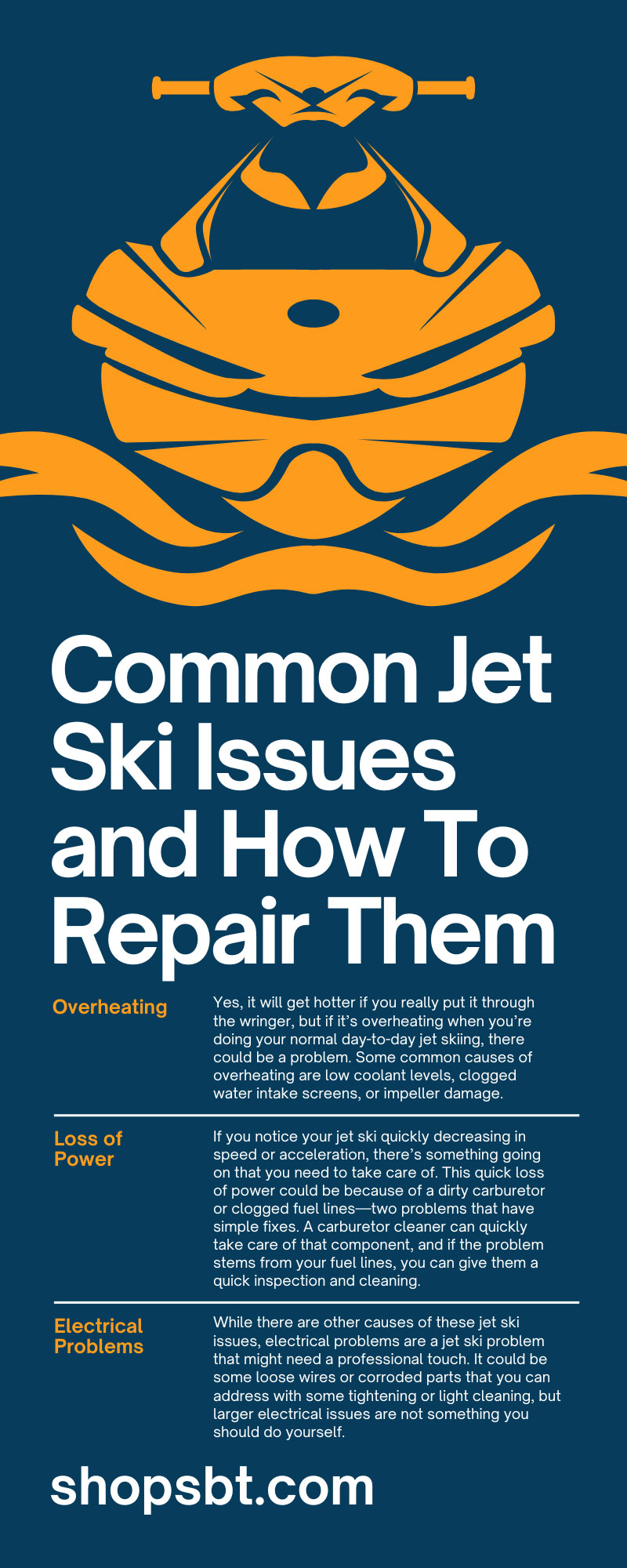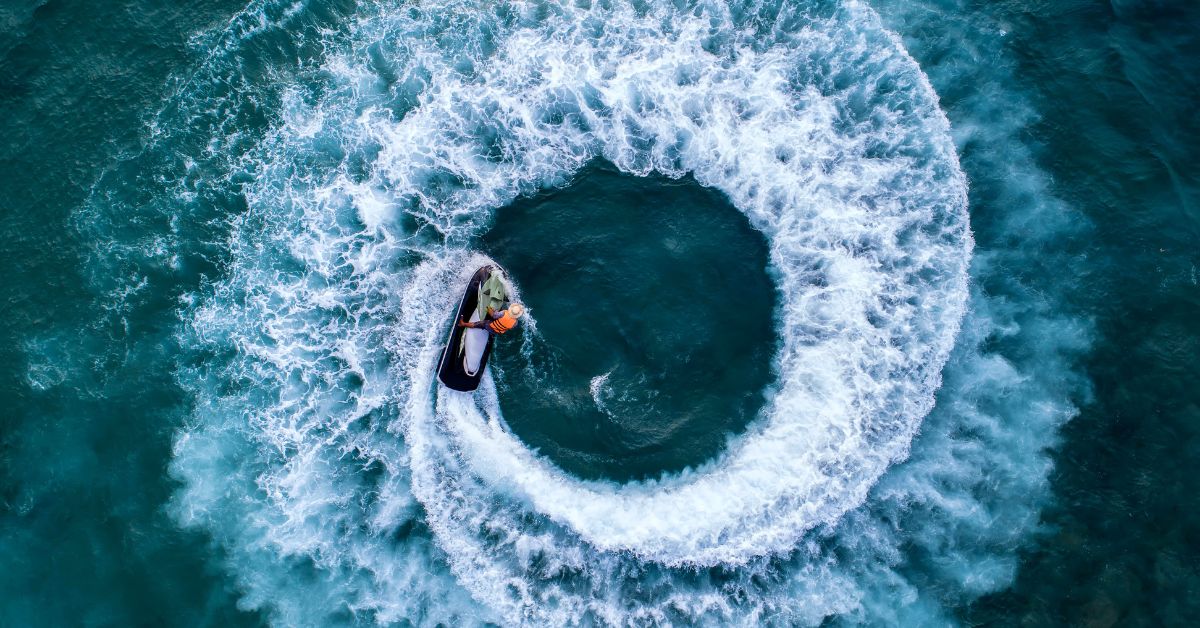Common Jet Ski Issues and How To Repair Them
Your jet ski is a fun tool for getting out on the water, but it’s not a perfect PWC that can last forever. It’s a complex interworking system of different parts, and there’s a lot of room for something to go wrong and bring down your experience. Thankfully, while there is a world of common jet ski issues, you can repair them if you really understand what’s going on. With the right knowledge of your PWC and what’s ailing it, you can handle repairs and get back on the water in no time at all!
Starting Issues
One of the biggest and most frustrating problems you can run into with your jet ski is that it simply won’t start. However, something so basic could stem from a lot of different things, including a:
- Dead battery
- Faulty starter
- Clogged fuel filter
If you want to repair a starter issue, you first need to identify the root cause. Check your battery first to make sure things are working there. If that’s not it, look at your spark plugs and clean, repair, or replace them if necessary. If these steps don’t fix your jet ski’s starter issue, it may be time to bring in some professional help. A mechanic can better diagnose complex problems and get your PWC back up and running.
Overheating
Another common jet ski issue you might notice is overheating. Yes, it will get hotter if you really put it through the wringer, but if it’s overheating when you’re doing your normal day-to-day jet skiing, there could be a problem. Some common causes of overheating are low coolant levels, clogged water intake screens, or impeller damage.
Make sure to turn off your engine immediately if you do notice it overheating so that you can stop the heat from damaging your jet ski further. Then, when your engine cools, you can investigate, diagnose the problem, and the take address it. Whether that’s adding coolant, replacing coolant entirely, or replacing a worn impeller blade, handle the problem quickly to ensure the problems don’t lead to costlier jet ski repairs.
Loss of Power
If you notice your jet ski quickly decreasing in speed or acceleration, there’s something going on that you need to take care of. This quick loss of power could be because of a dirty carburetor or clogged fuel lines—two problems that have simple fixes. A carburetor cleaner can quickly take care of that component, and if the problem stems from your fuel lines, you can give them a quick inspection and cleaning. Sometimes, it could have a leak, but a leak doesn’t mean the end of the world. A simple replacement can do the job!
A loss of power can seem disastrous, but it is avoidable. Take care of these repairs quickly. Just know that even with your jet ski back at 100 percent, there is more work to do. Be sure to regularly maintain and inspect these components so that you can prevent power loss in the future.
Electrical Problems
Faulty electrical systems can cause a range of issues, including engine stalling, failure to start, and loss of power. While there are other causes of these jet ski issues, electrical problems are a jet ski problem that might need a professional touch. It could be some loose wires or corroded parts that you can address with some tightening or light cleaning, but larger electrical issues are not something you should do yourself. A professional can help with diagnoses and repair, taking care of underlying problems such as failing stators or voltage regulators.
Water Leaks
Jet skis are PWCs, so it’s normal to encounter water. However, that water should only be in a few different places. Water leaks shouldn’t occur in the hull or exhaust system, places it can only get to through damaged seals and gaskets. These leaks not only affect performance but also pose a safety risk. If you start noticing water leaks, check the hull of your jet ski for cracks or damage, then repair them with marine-grade epoxy.
The exhaust system requires a little more finesse. Replacing damaged seals and gaskets here is important, but it will require a little bit more work. Either way, be sure to stay on the lookout for these leaks so you can immediately address them. The goal is to prevent further damage and keep you and your PWC safe the next time you’re out on the water.
Vibration or Shaking
Jet ski issues come in all shapes and sizes, and one big issue that can quickly derail a good time on the water is excessive vibration or shaking. A vibrating or shaking jet ski could stem from an unbalanced impeller, worn-out bearings, or a bent drive shaft. Inspect the impeller for balance and replace it if necessary. Check your bearings and drive shaft and replace them as needed. When you make sure all your jet ski’s components are in good condition, your next ride on the jet ski will be both smoother and safer.
Oil Leaks
Oil leaks can occur due to worn-out seals or gaskets, loose connections, or overfilled oil levels. These leaks not only affect performance but also pose a hazard to the water and surrounding environment. If you want to avoid these dangerous oil leaks, make sure to inspect seals and gaskets regularly and replace them if necessary. Additionally, you’ll want to tighten and secure all connections, as these will help maintain proper oil pressure in your jet ski. Take your time to also make sure that you’re not overfilling oil levels, as this can quickly lead to unwanted leaks and decreased performance.
Rust and Corrosion
Rust and corrosion are other common jet ski problems that can infiltrate just about every component of your jet ski. Repeat exposure to water, especially salt water, can damage your jet ski’s:
- Engine
- Exhaust system
- Other metal components
Make sure to regularly rinse your jet ski with fresh water after each use. Also, consider applying anti-corrosion spray to sensitive areas like the exhaust manifold and metal fittings. These layers of protection help keep your jet ski in top condition for years to come. Keeping your jet ski in a safe area free from the elements will also help reduce the risk of rust and corrosion.
A jet ski is a vehicle for hours of fun on the water, but that’s only if it works as it should. To make sure your PWC functions at its best, you need to know how to identify these common jet ski issues and how to repair them. Some repairs are simpler than others, but SBT is here to help with all of them with our jet ski top end rebuild kits. We have all the parts that you’ll need to get your jet ski back on the water in no time at all!



No Comments Yet